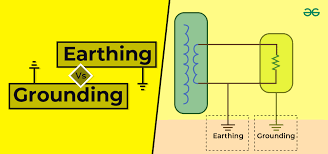
About Lesson
Earthing and Grounding
- Safety: Prevents electric shocks by providing a safe path for fault currents to flow into the ground, reducing the risk of electric shock to people.
- Equipment Protection: Protects electrical equipment from damage caused by fault currents, surges, and lightning strikes.
- System Stability: Ensures proper functioning of the electrical system by maintaining a reference point for voltage levels.
Key Concepts in Earthing and Grounding:
-
Earthing (or Grounding) Systems:
- System Earthing: Involves connecting parts of the electrical system to the earth to stabilize voltage and ensure safety. Common systems include:
- TN (Terra Neutral) Systems: Where the neutral point of the supply transformer is directly connected to earth.
- TT (Terra-Terra) Systems: Where the neutral is earthed at the supply transformer, and the exposed conductive parts are earthed independently.
- IT (Isolated Terra) Systems: Where the system is not directly connected to earth but is monitored for insulation resistance.
- System Earthing: Involves connecting parts of the electrical system to the earth to stabilize voltage and ensure safety. Common systems include:
-
Earthing Electrode:
- Types of Electrodes: Includes ground rods, plates, or meshes buried in the earth to establish an electrical connection.
- Materials: Typically made of copper or galvanized steel for corrosion resistance and good conductivity.
-
Grounding Conductors:
- Purpose: Carry fault currents from electrical systems to the earth.
- Types: Include grounding wires, conductors, and bonding straps.
